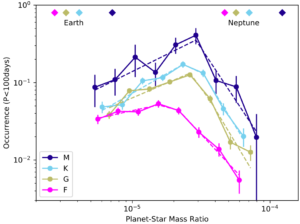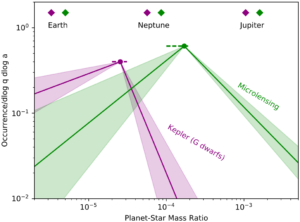
Figure 1: The number of planets per star as a function of the planet-star mass ratio as discovered by Kepler. Dark and light blue curves are for stars less massive than the Sun, while the pink curve is for more massive stars. From Pascucci et al. (2018).
Among the mind-blowing discoveries of the Kepler Mission is that the most common type of planet in the galaxy is the super-Earth/sub-Neptune. This unexpected type of planet straddles the boundary between Earth and Neptune in size and mass, and so they may be super-sized rocky planets or anemic gas-rich planets. We just can’t tell.
Stranger still is that this bizarre chimera orbits one out of every four stars in the Milky Way, but we don’t seem to have one in our solar system (unless the Planet Nine hypothesis pans out).
If that wasn’t enough to make you feel like a planetary outsider, a recent study suggests most planet systems have very different architectures from our own.
In their paper, Prof. Ilaria Pascucci of the University of Arizona and her colleagues studied the distribution of masses for planets discovered by the Kepler Mission. Unlike other recent work, though, they considered not just the planet masses but how they compare to the masses of their parent stars.
Naively, we might expect that more massive stars grow more massive planets, and there is good evidence that more massive stars host more massive dust disks. So as long as the processes that make planets are happy to operate around most any kind of star, then we can use the distribution of planet-star mass ratios to disentangle the influence of stellar mass from other effects.
And Pascucci et al. found exactly what we expected – big stars, small stars, they are all more likely to host planets more massive than Earth — but only up to a point. As shown in Figure 1, the number of planets per star increases with the planet-star mass ratio until it reaches about 0.00003 (or 10 Earth masses for one solar mass) — somewhere between the Earth and Neptune. Above that ratio, the occurrence rate drops, meaning more massive planets are less and less common.
But something even more interesting emerged when Pascucci et al. compared their results based on the Kepler Mission to other surveys. Because Kepler is good at finding planets close to their host stars and not at finding planets farther away, Pascucci’s results don’t tell us much about planets in orbits like Jupiter’s. But microlensing surveys, which use a totally different planet-finding technique, *are* good at finding these more distant planets.

Figure 2: The number of planets around each star with a given planet-star mass ratio for planets close to their host star (as found by Kepler) and planets farther away (as found by microlensing surveys). From Pascucci et al. (2018).
Comparing mass ratios from the two kinds of surveys, Pascucci et al. showed more distant planets found by microlensing also show a preference, but for a ratio several times larger than what’s preferred by closer-in planets — somewhere between Neptune and Jupiter in mass, as shown by the figure above.
What does this all mean? Apparently, the universe seems to like make planets about ten thousand times less massive than their host stars, whether the stars are tiny red dwarfs or massive F-stars. And the farther away the planet is from its star, the more likely it is to be more massive.
Standard planet formation theory predicts this trend: protoplanetary disks (from which planets form) have more solid, icy material farther from the host star, and more solids means more planet.
But these results also make our solar system look even stranger than before. In most solar systems, orbits like Earth’s (and closer) are occupied by planets somewhere between Earth and Neptune in mass, and more distant orbits like Jupiter’s are occupied by planets between Neptune and Jupiter.
It’s tempting to speculate that things that make the solar system unique in one way (in this case, the type of planets we have) are related to other unique things (like, the fact that there’s life here). We don’t know much about super-Earths, but if they turn out to be more Neptune- than Earth-like, it’s not hard to imagine they wouldn’t be good places for life to get started.
Life as we know it needs a planet with a solid surface and lots of liquid water, and so maybe it’s not surprising we haven’t found life elsewhere in the galaxy yet: most of the planets are lifeless, gas balls.